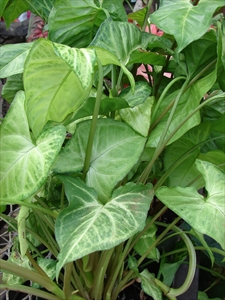- Worldwide distribution. In Australia, American Samoa, Cook Islands, Federated States of Micronesia, French Polynesia, Guam, New Caledonia, Niue, Palau, Solomon Islands.
- Invasive, fast-growing, creeping/climbing epiphyte in disturbed/undisturbed forests, forest margins, wastelands, wetlands, roadsides, agricultural land, smothering trees and preventing understory growth. Favours shade, sandy or loamy soils. An environmental threat.
- Vines up to 10m, with aerial roots, Young leaves undivided, spear-shaped; mature leaves, divided (three and later up to nine leaflets) on long stalks. Flowers, tubular, clustered in leaf axils, with sheath enclosing male and female parts (like taro and other aroids).
- Spread: creeping/climbing habit over short distances; longer, via trade in horticultural plants. Seeds rare.
- Biosecurity: international trade in plants; note, available on Internet.
- Biocontrol: none.
- Cultural control: hand-pulling (use gloves to avoid sap); collect stem pieces and burn.
- Chemical control: in Australia, triclopyr; fluroxypyr; fluroxypyr + aminopyralid; metsulfuron-methyl; 2,4-D; glyphosate. Use stem-scraping method applying herbicide with paint brush.







